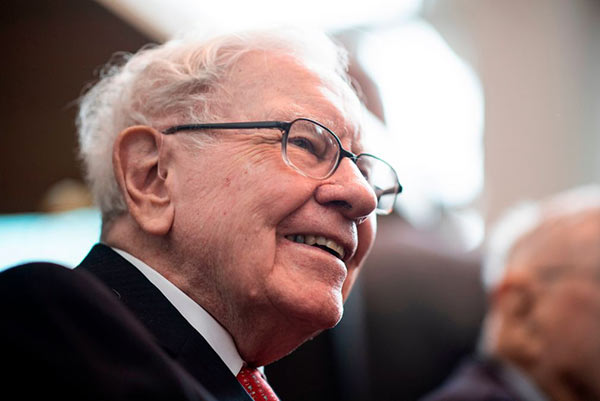Should you follow Warren Buffett into Japan?
Cherry Reynard explains why Japanese shares have had a strong start to the year and assesses whether the unloved market’s revival will continue.
21st August 2023 14:08
by Cherry Reynard from interactive investor

After 30 years where the Japanese market has been entirely friendless, it is suddenly everyone’s favourite investment. Warren Buffett, pictured, has built up a $15 billion (£11.7 billion) stake in the Japanese market this year, while Goldman Sachs says the country is at a “fascinating time” and raised its price targets. Foreign investors are taking an interest once again, ploughing $15.9 billion into Japanese shares in April alone.
- Invest with ii: Invest in Unit Trusts | Top Investment Funds | Top ISA Funds
Why the sudden love for Japan? There are structural reasons dating back to the “Abenomics” experiment of the early 2010s. Former prime minister Shinzo Abe launched his “three arrows” to get the country’s sclerotic economy working again. He increased the nation’s money supply through interest rate policy, while boosting government spending, and enacting reforms to make Japanese businesses more effective and competitive.
It is this corporate reform that has got investors particularly excited more recently. While this has been bubbling since the Corporate Governance Reform Act and new Stewardship code in 2012, the bazooka has been recent moves by the Tokyo Stock Exchange (TSE) to boost shareholder value. James Salter, at Japan specialist Zennor Asset Management, says: “The Exocet was the TSE saying that half the market trades below book value and it wanted those companies to trade above book on a three-to-four-year view.”
Japanese shares have had a good start to the year
Stock market index | 2023 | 2022 | 2021 | 2020 | 2019 |
Euro STOXX 50 | 11.66 | -6.66 | 15.72 | 6.51 | 20.01 |
S&P 500 | 11.43 | -8.25 | 29.34 | 14.12 | 25.65 |
Nikkei 225 | 8.72 | -10.59 | -5.15 | 18 | 15.83 |
FTSE 100 | 5.31 | 4.7 | 18.44 | -11.55 | 17.32 |
Source: FE FundInfo, total return in GBP, as of 27 July 2023.
Companies now have to evidence what they are doing to improve metrics such as return on equity (a measure of the return they get on the investments they make), and price to book. Salter points out that if every stock that trades below book value were to make it to book value, the Nikkei 225 would go to 45,000, from its current level of 31,565. “If they get it right, that’s what we can aim for. What it means for a stock picker is much, much greater.”
The second structural dynamic is a reversal of Japan’s long-running deflation problem. This had long been a headwind for Japanese corporates and a major deterrent for international investors. While other major economies are struggling with inflationary pressures, for Japan, rising prices are welcome.
- DIY Investor Diary: how I apply Warren Buffett tips to fund investing
- The one equity sector fund investors are buying
Masaki Taketsume, manager of the Schroder Japan Trust (LSE:SJG), says: “Japan is now moving towards an inflationary environment. Currently, inflation is rising as a result of higher input costs such as commodity prices. But this year, that driver of inflation is changing from input costs to wages. Companies can raise their prices, the consumer has greater purchasing power to buy those products because of rising wages. It becomes a virtuous cycle.
“This is a different dynamic on inflation and should help domestic companies. Companies can realise profit growth – volume growth and price increases.”
A final, shorter-term catalyst for Japan’s recent strength is that it’s a different point in its economic cycle. In contrast to Western economies, who experienced their post-pandemic economic boost two years ago, Japan’s recovery is just getting started.
Taketsume says: “In the case of Japan, we only just opened the economy late last year, so we are still in the early stages of a cyclical recovery. In this respect, Japan has an advantage over other global markets.”
The result has been a 23% rise in the Nikkei for the year to date (to 10 July 2023). That puts it ahead of the S&P 500, which returned just 14%, the Eurostoxx, at 110%, and the FTSE 100, with an unimpressive -3.4% return. The returns for UK fund investors have been held back by the relative performance of the yen versus the pound, with the average fund in the IA Japan sector up just 6.1%, and 8.7% in the AIC Japan sector.
Will the rally continue?
The question is whether all the gains have already been made. Salter makes the point that the capital directed towards Japan has not been going into those companies that benefit most from corporate governance reform: “A lot is futures or hedge-fund led. At a time when we’re saying buy Japan for higher inflation and corporate governance reform, they’ve bought artificial intelligence (AI) stocks. The foreigner always tends to buy high and sell low in Japan.” He believes that foreign interest is important, but not necessary to realise the value in Japanese equities.
He sees value in smaller and mid-sized Japanese companies that haven’t benefited from money flowing into the Japanese market to date. This means that active managers specialising in these areas, such as Baillie Gifford, have not participated in the strong performance.
- Should you invest in Baillie Gifford funds or investment trusts?
- Investors are becoming more optimistic again – here’s what they are buying
Yet the largest index constituents will probably not be the key beneficiaries of the corporate governance reform. As Taketsume points out, high-quality companies such as Sony Group Corp ADR (NYSE:SONY) already have strong corporate governance and high returns on equity. It is the lower value segment, plus small and mid-caps, where the most interesting opportunities are to be found.
That said, investors need to be careful. Not all companies will make the grade. Fortunately, the Japanese managers that have survived the past three decades of bear markets are generally good stockpickers. The weaker ones have long since gone by the wayside.

How should you invest in Japan?
Paul Green, investment manager in the multi-manager team at Columbia Threadneedle Investments, says: “The businesses ripest for change are those that are cheap, have large amounts of cash on their balance sheet, depressed profitability, and a low payout ratio. However, after generations of steadfastness, not all companies will change – undoubtedly, there will inertia among some established management teams, so it’s crucial for an active approach to identify those companies that are most open to change.”
He adds that the emergence of inflation in Japan, albeit at levels much lower than other developed economies, should be welcomed by ‘value’ companies too – boosting the top line of companies that haven’t seen any pricing power for a very long time.
He says: “The valuation opportunity sits across the market-cap spectrum but in our opinion, the under-researched mid and small-cap area is likely to be the most fruitful. Since Japan has been ignored for so long by international investors, many brokers have pulled their research away from smaller companies to focus solely on the large-cap areas of the market, this presents a great alpha opportunity for active and patient capital.”
He suggests investors look at the team at Morant Wright, who are mid-small cap value specialists that manage LF Morant Wright Japan fund, and the duo of James Salter and David Mitchinson at Zennor, particularly their newly launched LF Zennor Japan Equity Income fund.
Andrew McCagg, senior client portfolio manager at Nomura Asset Management, agrees that active funds are likely to be the best approach: “With more than 1,800 stocks, the TOPIX is a broad index that is under-covered, creating market inefficiencies active managers can take advantage of over the longer term, regardless of style.”
He adds: “So far in 2023, the style performances have flipped each month, with growth outperforming value in odd months and vice versa in even months. As this mirrors the uncertainty in the markets regarding the global economy, we could continue to see this see-saw performance between the styles going forward.”
- Why diversification is back – and how to do it properly
- Ian Cowie: home to my first 10-bagger trust, this market is just getting started
Value companies could benefit from improving corporate governance and shifting monetary policy, particularly financials. However, McCagg doesn’t rule out growth: “A sustained tech rally driven by AI expectations could continue to provide some upside for semiconductor-related names and other cyclical growth stocks in the short term.”
He agrees that small and mid-caps are a fertile hunting ground, saying that while large-caps have outperformed small-caps over the last several years, there may now be a rotation into small-caps due to a global recession.
“One of the only times small-caps outperformed large-caps recently was the second half of 2022, when global recessionary concerns started to weigh on markets. In 2023, large-caps have once again outperformed small-caps…However, if we assume central banks will induce a recession in order to tame inflation, then we will likely see small-caps outperform in that environment,” McCagg said.
There has been a strong rally in Japan, but to date, this has been relatively narrow and not led by those companies likely to benefit most from corporate governance reform and rising inflation. While growth areas of the market, such as semiconductors, may still see improving share prices, the value in the “value” and small/mid-cap areas of the market is yet to be realised. This is where investors should focus their attention, according to the experts.
How currency changes impact your investments
The return on Japanese and American shares this year in the home currencies have been far higher than their return in pounds. This is because this year the pound has been strong, rising in value and against the yen and the dollar, therefore making returns less when converted back into pounds.
The pound has risen 5.5% against the dollar and 18.5% against the yen in 2023, wiping out the same amount of the index returns in local currency for UK-based investors.
Choosing a “hedged” fund share class will cut currency risk as the fund manager will use derivatives to eliminate the impact of currency swings, but there are no guarantees it will work perfectly and it adds to fund fees.
These articles are provided for information purposes only. Occasionally, an opinion about whether to buy or sell a specific investment may be provided by third parties. The content is not intended to be a personal recommendation to buy or sell any financial instrument or product, or to adopt any investment strategy as it is not provided based on an assessment of your investing knowledge and experience, your financial situation or your investment objectives. The value of your investments, and the income derived from them, may go down as well as up. You may not get back all the money that you invest. The investments referred to in this article may not be suitable for all investors, and if in doubt, an investor should seek advice from a qualified investment adviser.
Full performance can be found on the company or index summary page on the interactive investor website. Simply click on the company's or index name highlighted in the article.